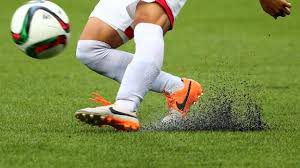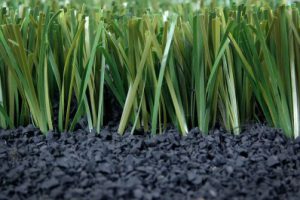Feds Urged to Complete Study Assessing Safety of Crumb Rubber Playing Fields, Playgrounds
/If at first you don’t succeed, try, try again. That’s not only a well-worn adage from youth, it is apparently the game plan for Connecticut U.S. Sen. Richard Blumenthal and his multi-year quest for a comprehensive federal study of the health risks of crumb rubber turf, a surface made of recycled tires that is widely used on playgrounds and athletics fields in Connecticut and nationwide.
Blumenthal, along with colleagues in the Senate, are this week urging a federal task force to finish a long-overdue study into potential health risks. The crumb rubber used in artificial turf fields is mainly composed of recycled tires, which contain man-made and natural rubber, according to the state Department of Public Health. Chemicals called polycyclic aromatic hydrocarbons (PAHs) and volatile organic compounds (VOCs) can be found in the crumb rubber. Crumb rubber can also contain heavy metals such as zinc and copper.
After a year and a half, WTNH-TV reported, the Senators are convinced progress on a comprehensive federal study has stalled.
It isn’t the first time that Blumenthal has been a lead voice to prompt action. In November 2015 Blumenthal and Senate colleague Bill Nelson of Florida urged the Consumer Product Safety Commission to conduct a study. In March 2016, Blumenthal was among those urging Congress and the President to allocate sufficient funds to conduct the study. “Parents deserve to know if there is a danger to their children playing on these fields,” he said that month at a news conference held at Yale University.
 A synthetic turf study was undertaken in 2016 by four United States agencies — EPA, Consumer Products Safety Commission, the Centers for Disease Control and Prevention/Agency for Toxic Substances and Disease Registry — which has yet to be finalized.
A synthetic turf study was undertaken in 2016 by four United States agencies — EPA, Consumer Products Safety Commission, the Centers for Disease Control and Prevention/Agency for Toxic Substances and Disease Registry — which has yet to be finalized.
With it’s completion in doubt, Blumenthal is highlighting the imperative to get scientific answers to guide communities that are considering how best to replace natural grass or other types of field surfaces. It is estimated that there are more than 10,000 artificial-turf surfaces in use across the country.
Earlier this year, plans for a crumb rubber synthetic turf field in North Haven brought local opposition. The town decided to go forward with the less controversial encapsulated crumb-rubber infill over the traditional crumb rubber option, according to an article on the controversy published this month in The Atlantic.
Last year, Hamden opted not to go ahead with plans for crumb rubber, switching to a mix of cork shavings and coconut husk, called “GeoFill,” along with a “shock pad” in response to safety concerns. Bloomfield High School installed a synthetic turf field, South Windsor decided to use acrylic-coated sand instead of crumb rubber. Madison and Guilford are also among the communities with crumb rubber surfaces for fields or playgrounds, according to published reports.
Testifying at the Connecticut State Capitol earlier this year, medical staff from the Children’s Environmental Health Center at the Icahn School of Medicine at Mount Sinai in New York City, urged that “Until the findings of these studies are available and conclusively demonstrate the safety of recycled rubber playground surfaces, we recommend a ban on the use of these materials where children play.”
Legislation that would have prohibited the installation of ground cover that contains shredded or ground rubber recycled from motor vehicle tires in municipal and public school playgrounds in Connecticut was approved by two legislative committees (Committee on Children, Committee on Planning & Development) in March, but the proposal was not considered by the full legislature in the session that concluded in June.
 Blumenthal first became concerned about the artificial surface when his children were playing on the crumb-rubber athletic fields. “I became concerned as a parent, as much as a public official, ten years ago, and at first was somewhat skeptical, but now very firmly believe that we need an authoritative, real study about what’s in these fields,” Blumenthal told ABC News two years ago.
Blumenthal first became concerned about the artificial surface when his children were playing on the crumb-rubber athletic fields. “I became concerned as a parent, as much as a public official, ten years ago, and at first was somewhat skeptical, but now very firmly believe that we need an authoritative, real study about what’s in these fields,” Blumenthal told ABC News two years ago.
The state Department of Public Health (DPH) website points out that “the advantages of these fields include less maintenance costs, ability to withstand intense use and no need for pesticides.” To address public safety concerns, four Connecticut state agencies collaborated in 2010 to evaluate the potential exposures and risks from athletic use of artificial turf fields, the DPH website explains.
A two year investigation of releases from five fields during active play was conducted by the Connecticut departments of Public Health, Energy and Environmental Protection, University of Connecticut Health Center, and The Connecticut Agricultural Experiment Station. The study was peer-reviewed by the Connecticut Academy of Science and Engineering.
The overall conclusion of the report, according to the DPH website, is that “use of outdoor artificial turf fields does not represent a significant health risk.” A news release issued by the department did note “higher contaminant levels at one indoor field indicate that ventilation of indoor fields should be considered. Storm water run off findings indicate that proper management of this run off is prudent to address possible environmental effects.”





























